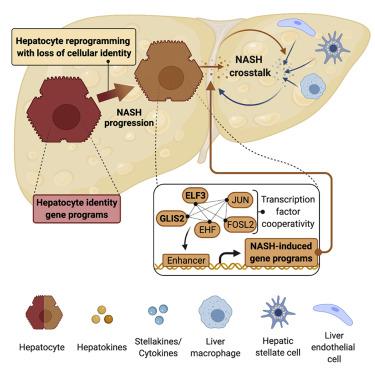Cell Metabolism ( IF 27.7 ) Pub Date : 2021-07-07 , DOI: 10.1016/j.cmet.2021.06.005 Anne Loft 1 , Ana Jimena Alfaro 2 , Søren Fisker Schmidt 1 , Felix Boel Pedersen 3 , Mike Krogh Terkelsen 3 , Michele Puglia 4 , Kan Kau Chow 2 , Annette Feuchtinger 5 , Maria Troullinaki 2 , Adriano Maida 2 , Gretchen Wolff 2 , Minako Sakurai 2 , Riccardo Berutti 6 , Bilgen Ekim Üstünel 2 , Peter Nawroth 7 , Kim Ravnskjaer 3 , Mauricio Berriel Diaz 2 , Blagoy Blagoev 3 , Stephan Herzig 2

|
Liver fibrosis is a strong predictor of long-term mortality in individuals with metabolic-associated fatty liver disease; yet, the mechanisms underlying the progression from the comparatively benign fatty liver state to advanced non-alcoholic steatohepatitis (NASH) and liver fibrosis are incompletely understood. Using cell-type-resolved genomics, we show that comprehensive alterations in hepatocyte genomic and transcriptional settings during NASH progression, led to a loss of hepatocyte identity. The hepatocyte reprogramming was under tight cooperative control of a network of fibrosis-activated transcription factors, as exemplified by the transcription factor Elf-3 (ELF3) and zinc finger protein GLIS2 (GLIS2). Indeed, ELF3- and GLIS2-controlled fibrosis-dependent hepatokine genes targeting disease-associated hepatic stellate cell gene programs. Thus, interconnected transcription factor networks not only promoted hepatocyte dysfunction but also directed the intra-hepatic crosstalk necessary for NASH and fibrosis progression, implying that molecular “hub-centered” targeting strategies are superior to existing mono-target approaches as currently used in NASH therapy.
中文翻译:

肝纤维化激活的转录网络控制肝细胞重编程和肝内通讯
肝纤维化是代谢相关性脂肪肝患者长期死亡率的重要预测指标;然而,从相对良性的脂肪肝状态发展到晚期非酒精性脂肪性肝炎 (NASH) 和肝纤维化的机制尚不完全清楚。使用细胞类型分辨基因组学,我们表明在 NASH 进展过程中肝细胞基因组和转录设置的全面改变导致肝细胞身份丧失。肝细胞重编程受到纤维化激活转录因子网络的紧密协作控制,例如转录因子 Elf-3 (ELF3) 和锌指蛋白 GLIS2 (GLIS2)。事实上,ELF3 和 GLIS2 控制的纤维化依赖性肝因子基因靶向疾病相关的肝星状细胞基因程序。











































 京公网安备 11010802027423号
京公网安备 11010802027423号